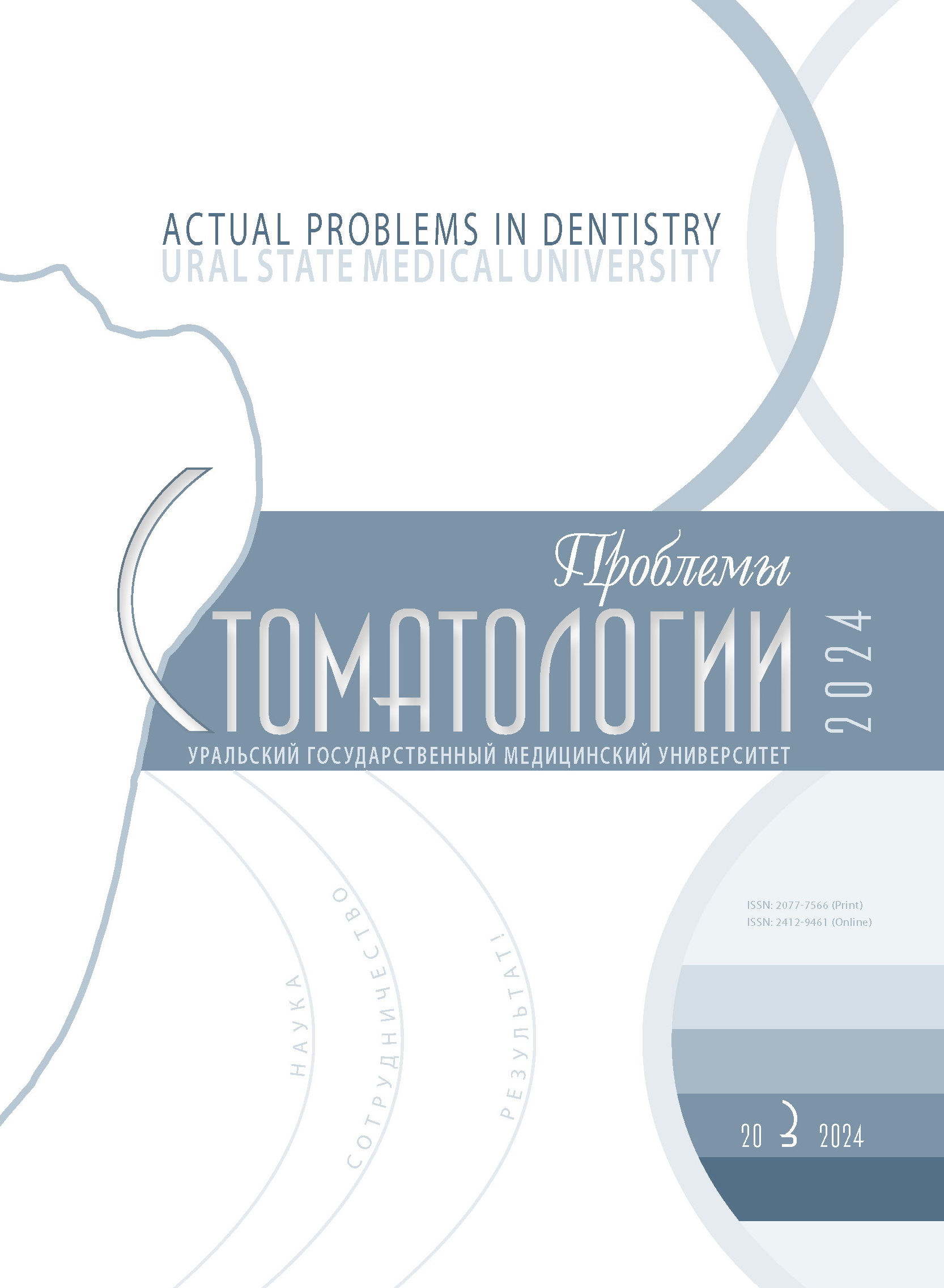Ekaterinburg, Russian Federation
Ekaterinburg, Ekaterinburg, Russian Federation
Yekaterinburg, Ekaterinburg, Russian Federation
Yekaterinburg, Ekaterinburg, Russian Federation
Ekaterinburg, Russian Federation
Ekaterinburg, Ekaterinburg, Russian Federation
Ekaterinburg, Ekaterinburg, Russian Federation
Yekaterinburg, Ekaterinburg, Russian Federation
UDC 616.31
Subject. The subject of this study is xerostomia. Objectives. The aim of the study is to evaluate xerostomia manifestations in women with chronic periodontitis and reduced bone mineral density of the skeleton. Methodology. The study is conducted by the Department of Therapeutic Dentistry and Propaedeutics of Dental Diseases, Ural State Medical University. The study involved 96 patients: 76.7% of those with age 45–59 years old, and 23.3% of those with age 60–65 years old. The two study groups were formed: the first group comprised 66 patients with chronic generalized periodontitis of moderate severity and reduced bone mineral density; the second (reference) group comprised 30 conditionally healthy female patients with chronic generalized mild periodontitis in remission and normal bone mineral density of the skeleton. The clinical assessment of dental parameters in patients and online questionnaire survey with special questions modified by us were carried out to determine the aspects of xerostomia and the system state. Conclusions. Analysis of the findings reveals the feasibility of conducting the survey – the use of the summated rating scale responses to Xerostomia Inventory Questionnaire and clinical scoring scales for assessment of xerostomia for xerostomia diagnosis in women with chronic periodontitis of moderate severity, as well in those with reduced bone mineral density. It can be useful in identifying and analyzing risk factors, non-specific causes, prevalence of permanent, periodic and latent xerostomia, initial and clinically definite xerostomia. These methods allow to define the stomatological and somatic status of patients, adequately set up a comprehensive treatment plan, consultations and dynamic monitoring not only by dental and periodontal specialists but also by such specialized medical professionals as rheumatologist, endocrinologist, ophthalmologist, otolaryngologist and others, if necessary.
xerostomia, reduced bone mineral density of the skeleton, osteoporosis, oral fluid, mixed saliva
1. Afanas'ev V.V., Vinokurov N.S. Rezul'taty ispol'zovaniya opolaskivatelya xerostom v kompleksnom lechenii pacientov s kserostomiey. Rossiyskiy stomatologicheskiy zhurnal. 2020;24(5):318-320. [V.V. Afanasyev, N.S. Vinokurov. Results of using the xerostom rinse aid in the complex treatment of patients with xerostomia. Russian Journal of Dentistry. 2020;24(5):318-320. (In Russ.)]. DOIhttps://doi.org/10.17816/1728-2802-2020-24-5-318-320
2. Afanas'ev V.V., Pavlova M.L., Ordashev H.A. Kserostomiya. Suhost' polosti rta. Etiologiya, patogenez, klinicheskaya kartina, diagnostika i lechenie. Moskva : GEOTAR-Media. 2019. [V.V. Afanasyev, M.L. Pavlova, Kh.A. Ordashev. Xerostomia. Dry mouth. Etiology, pathogenesis, clinical picture, diagnosis and treatment. Moscow : GEOTAR-Media. 2019. (In Russ.)]. https://www.troykaonline.com/Kserostomiia_sukhost_polosti_rta_Etiologiia_patogenez_klinicheskaia_kartina_diagnostika_i_lechenie_V_V_Afanas_ev_M_L_Pavlova_Kh_A_Ordashev_M_GEOTAR-Media_2019_160_s_il_596292.html
3. Volosova E.V., Panin A.M., Ciciashvili A.M., Shishkanov A.V., Nil'va A.I. Problemy diagnostiki i lecheniya pacientov s kserostomiey. Sovremennyy vzglyad. Medicinskiy alfavit. 2020;(35):44-47. [E.V. Volosova, A.M. Panin, A.M. Tsitsiashvili, A.V. Shishkanov, A.I. Nilva, A.I. Yevdokimov. Problems of diagnostics and treatment of xerostomia. Current view. Medical Alphabet. 2020;(35):44-47. (In Russ.)]. https://doi.org/10.33667/2078-5631-2020-35-44-47
4. Grigor'ev S.S., Sablina S.N., Elovikova T.M. i dr. Ocenka stomatologicheskih pokazateley kachestva zhizni zhenschin s hronicheskim parodontitom i snizhennoy mineral'noy plotnost'yu kostnoy tkani na etapah dinamicheskogo nablyudeniya i podderzhivayuschey terapii. Problemy stomatologii. 2024;20(2):99-104. [S.S. Grigoryev, S.N. Sablina, T.M. Elovikova et al. Evaluation of dental parameters of the quality of life for women with chronic periodontitis and reduced bone mineral density during dynamic monitoring and supportive therapy. Actual Problems in Dentistry. 2024;20(2):99-104. (In Russ.)]. DOIhttps://doi.org/10.18481/2077-7566-2024-20-2-99-104
5. Grigor'ev S.S., Sablina S.N., Elovikova T.M. i dr. Patogeneticheskie i associativnye vzaimosvyazi parametrov zdorov'ya tkaney parodonta i mineral'noy plotnosti kostnoy tkani u zhenschin, prozhivayuschih v megapolise. Parodontologiya. 2023;28(4):369-379. [S.S. Grigoryev, S.N. Sablina, T.M. Elovikova et al. Pathogenetic and associative relationships between the parameters of periodontal health and bone mineral density in women living in a megalopolis. Parodontologiya. 2023;28(4):369-379. (In Russ.). DOIhttps://doi.org/10.33925/10.33925/1683-3759-2023-751
6. Tarasova Yu.G., Dmitrakova N.R., Zlobina O.A., Subbotina A.V. Rasprostranennost' i faktory riska kserostomii na prieme u stomatologa-terapevta. Institut stomatologii. 2023;1(98):67-69. [Yu.G. Tarasova, N.R. Dmitrakova, O.A. Zlobina, A.V. Subbotina. Prevalence and risk factors for xerostomia at the dentist visit. The Dental Institute. 2023;1(98):67-69. (In Russ.)]. https://www.elibrary.ru/item.asp?id=50522421
7. Ahonen H., Pakpour A., Norderyd O., Broström A., Fransson E.I., Lindmark U. Applying World Dental Federation Theoretical Framework for Oral Health in a General Population // Int Dent J. – 2022;72(4):536-544. doihttps://doi.org/10.1016/j.identj.2021.09.001
8. Assy Z., Jager D.H.J., Mashhour E., Bikker F.J., Brand H.S. Regional differences in perceived oral dryness as determined with a newly developed questionnaire, the Regional Oral Dryness Inventory // Clin Oral Investig. – 2020;24(11):4051-4060. doihttps://doi.org/10.1007/s00784-020-03276-7
9. Assy Z., Brand H.S., Bots C.P., Bikker F.J. The relationship between the severity of oral dryness and the use of dry-mouth interventions by various subgroups of dry-mouth patients // Clin Oral Investig. – 2022;26(3):3097-3108. doihttps://doi.org/10.1007/s00784-021-04292-x
10. Dreyer N.S., Lynggaard C.D., Jakobsen K.K., Pedersen A.M.L., von Buchwald C., Grønhøj C. Xerostomia // Ugeskr Laeger. – 2021;183(27):V11200814. https://pubmed.ncbi.nlm.nih.gov/34219641/
11. Dodds M.W.J., Haddou M.B., Day J.E.L. The effect of gum chewing on xerostomia and salivary flow rate in elderly and medically compromised subjects: a systematic review and meta-analysis // BMC Oral Health. – 2023;23:406. https://doi.org/10.1186/s12903-023-03084-x
12. Flink H., Tegelberg Å., Arnetz J.E., Birkhed D. Self-reported oral and general health related to xerostomia, hyposalivation, and quality of life among caries active younger adults // Acta Odontol Scand. – 2020;78(3):229-235. doihttps://doi.org/10.1080/00016357.2019.1690677
13. Hijjaw O., Alawneh M., Ojjoh K. et al. Correlation between Xerostomia index, Clinical Oral Dryness Scale, and ESSPRI with different hyposalivation tests // Open Access Rheumatol. – 2019;11:11-18. doihttps://doi.org/10.2147/OARRR.S188937
14. Jager D.H.J., Bots C.P., Forouzanfar T., Brand H.S. Clinical oral dryness score: evaluation of a new screening method for oral dryness // Odontology. – 2018;106(4):439-444. doihttps://doi.org/10.1007/s10266-018-0339-4
15. Szabó G., Németh Z., Kivovics M. Clinical outcomes of NBF gel application in managing mucositis associated with xerostomia // Maxillofac Plast Reconstr Surg. – 2024;46(1):34. doihttps://doi.org/10.1186/s40902-024-00445-6
16. Stoopler E.T., Villa A., Bindakhil M., Díaz DLO, Sollecito T.P. Common Oral Conditions: A Review // JAMA. – 2024;331(12):1045-1054. doihttps://doi.org/10.1001/jama.2024.0953
17. Thakkar J.P., Lane C.J. Hyposalivation and Xerostomia and Burning Mouth Syndrome: Medical Management // Oral Maxillofac Surg Clin North Am. – 2022;34(1):135-146. doihttps://doi.org/10.1016/j.coms.2021.08.002
18. Ying Joanna N.D., Thomson W.M. Dry mouth - An overview // Singapore Dent J. – 2015;36:12-17. doihttps://doi.org/10.1016/j.sdj.2014.12.001




















